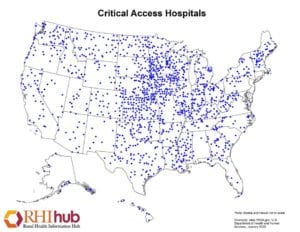
Rural health clinics (RHCs) and Critical Access Hospitals (CAHs) can save significant amounts of money and staff time by properly utilizing telehealth services, among other benefits. Many people were forced into using telehealth during the COVID-19 pandemic, as 27 percent of people used telehealth for the first time when surveyed at the end of May, including numerous seniors. Many of these people would not have tried telehealth before, but of those that have 79 percent said they would continue to use it after the pandemic.
The part that is really important to understand about this surge in telehealth usage is that 40% of users said they would be more likely to use telehealth services if they were able to see their own physician. As long as RHCs make sure that they make telehealth available quickly they can ensure local populations looking for telehealth services stay with them, otherwise many of these people will look for telehealth elsewhere or stay with options they have already found.
Diverse Benefits of Adopting Widespread Telehealth
According to a report done by the Institute of Medicine for the National Academies, telehealth in RHCs can increase the quality of care, improve hospital volume, and reduce costs by decreasing the amount of readmissions and avoidable visits to the ER.
Cost Savings from Telehealth for Rural Hospitals and Clinics
The US national average of hospital cost savings per medical facility was estimated to be $20,841 according to a report done by The Rural Broadband Association in 2017. While this number varies state by state, it accurately depicts the opportunity that RHCs have when it comes to increasing their savings each year.
The same report also found that savings accumulated by hospitals located in Arkansas, Kansas, Oklahoma and Texas ranged from $61,600 to over $100,000 dollars per year. The Rural Broadband Association found that this was largely due to medical facilities in rural areas having the ability to use telehealth technology.
Effectively Monitor Chronic Disease
 RHCs and CAHs that utilize telehealth technology are able to manage chronic disease efficiently. The ease and timeliness of technology enables healthcare providers to continuously monitor patients from afar who don’t have immediate access to care based on their location.
RHCs and CAHs that utilize telehealth technology are able to manage chronic disease efficiently. The ease and timeliness of technology enables healthcare providers to continuously monitor patients from afar who don’t have immediate access to care based on their location.
Telehealth also allows patients to engage in their own care process so they know what’s going on every step of the way and can begin to understand what to recognize and what to look out for. It also ensures that physicians and specialists can identify symptoms early on and intervene promptly when necessary. This can be especially significant for those with congestive heart failure, stroke, and chronic pulmonary disease.
For patients with chronic diseases who reside in rural areas, telehealth is an essential offering that will differentiate RHCs and CAHs and enable providers to monitor and treat individuals who are far away from the brick and mortar facility.
Patient Satisfaction and Retention
When patients are happy and receiving effective care, rural healthcare providers boost their reputation and build patient loyalty.
With so much competition in the healthcare industry, patients in rural areas are much more likely to seek out telehealth solutions rather than travel long distances to receive care. If your RHC does not offer telehealth services, it is easy for patients to choose an option that does.
Dr. Robert Bernstein, VP of Clinical Affairs at Carena Inc., a virtual care provider, says “A lot of health systems are in competition for customers – patients – and there’s certainly a lot of the competition out there that’s offering to meet the patient’s needs for less cost on the patient’s terms,” Bernstein said. “If you’re not doing that, you’re going to lose those patients. They’re going to go to retail clinics or independent telehealth vendors. You need to make sure you are attracting and maintaining your patient base.”
RHCs have the opportunity to make access to care simple and convenient for patients, which creates a positive ripple effect. For example, the Wall Street Journal reported that the average in-person visit to the doctor’s office costs $100 and up to $160 at an urgent-care clinic. A telehealth appointment for non-emergency reasons on average costs $45. That means a patient could be saving over $100 every time they virtually visit the doctor. When patients are happy with the service provided, they are likely to return again and again and will recommend the service to friends and family. Not only does this increase patient retention, but it also enhances awareness.
The Presbyterian Health Services of Albuquerque conducted a pilot project. It showed that patients receiving care via telehealth had similar or better outcomes to inpatients and they reported higher levels of satisfaction. In addition, it was discovered that telehealth patients saved 19 percent more than inpatients.
The better the experience, the higher the patient retention rate. Dr. Bernstein comments, “Take a parent whose child has ear pain that may indicate an ear infection, for example. It’s late Sunday night and with the options that are available to them – they’re likely to end up in the emergency room or urgent care. In addition to making their care more fragmented, most of the time an antibiotic isn’t needed right away even if there is an ear infection and it won’t help the ear pain that night, so an in-person visit isn’t particularly helpful. By having the ability to talk to someone through telemedicine, the provider can say ‘Here’s what we’re doing tonight to take care of your child tonight.”
Telehealth During COVID-19 and Beyond
Those in rural healthcare are beginning to see the value of telehealth. The Rural Health Clinic Modernization Act of 2019 (S 1037) was formed in order to “expand the services offered by rural health clinics to improve access to care and close coverage gaps in underserved areas of the country.”
The bill enables RHCs to be classified by Medicare as distant site providers, meaning they are able to expand their telehealth platforms to encompass more services and contract with physician assistants and nurse practitioners. The bill also improves reimbursement.
Tina Smith (D-MN), who introduced the bill along with Sens. John Barrasso (R-WY), said, “We need to do everything we can to make sure that people in rural areas are able to get healthcare. While there have been significant changes in the health care system, many of the laws focusing on Rural Health Clinics haven’t been updated in over 40 years. Our bipartisan bill would fix some of the old rules that are in need of these upgrades. … This legislation is really about making sure at the end of the day people are going to be able to get the vital care Rural Health Clinics provide in underserved, rural areas.”
In April of 2020, a document was released by the Centers for Medicare & Medicaid Services (CMS) in order to give clarity around changes that were made to Medicare reimbursement in relation to the Coronavirus Aid, Relief, and Economic Security (CARES) Act.
These changes included RHCs to be able to implement telehealth and permitted doctors within these RHCs to work from home. To learn more about the benefits of the changes made in regards to telehealth and RHCs click here.
It is also beneficial for RHCs to note that in May of 2020, CMS Administrator Seema Verma shared that the new Medicare telehealth policy would also provide coverage for services such as home dialysis, mobile stroke unit technologies, in-home monitoring, and remote information sharing. Verma claimed that CMS will also be reimbursing RHCs for any virtual check-ins conducted.
Even after COVID-19 passes, healthcare is moving towards more advanced technological innovation and if RHCs want to remain relevant, competitive, and offer quality care to their patients, telehealth is a must.
Make sure Your Clinic is Ready for Telehealth
Telehealth brings many new opportunities, but it also brings a lot of fresh challenges. It is important to make sure that healthcare providers know the fundamentals of telehealth to be able to navigate the associated challenges that come along with it: scheduling, technology issues, privacy concerns, and how to translate different practices to the virtual medium effectively.
Many healthcare providers are taking the initiative to become Board Certified Telepractice Specialists in order to ensure that they understand and are well versed in all of the fundamentals of telepractice.
This allows them to know that they have all of the fundamental knowledge they need so they can focus on delivering the healthcare that they are trained to deliver instead of worrying about the details of how to properly administer telehealth effectively.
This also helps to show patients that they are well versed in telehealth to reassure patients that their care is not going to be compromised.
Telehealth’s Role in Underserved, Rural America
Unfortunately, there are still many individuals in rural areas who struggle to get access to the proper care they need.
A report conducted by NPR, Harvard’s T.H. Chan School of Public Health, and the Robert Wood Johnson Foundation, found that while the majority of rural Americans do have health insurance coverage, their access to healthcare remains a large issue. The report also discovered that 25 percent of Americans living in rural areas do not have immediate access to care and about 25 percent also rely on telehealth to receive treatment and access to services.
Robert J. Blendon, the co-director of the survey and the Richard L. Menschel professor of health policy and political analysis at Harvard T.H. Chan School of Public Health, said “Even with major improvements in health insurance coverage over the last decade, it is concerning that one in four rural Americans are struggling to get the health care they need.”
The survey also discovered that 69 percent of rural Americans who were using telehealth services chose the platform due to convenience. Other individuals utilized telehealth services when they were not able to seek care face-to-face.
Having telehealth services available in RHCs is one of the best ways to bring required care to rural Americans who are struggling to have access.
Telehealth Certification to Prepare your Staff for the Transition
Make sure your staff is properly trained to administer telehealth. This way you can ensure patient satisfaction and that your staff are ready to deliver telehealth services effectively, understanding all the nuances of the differences between telehealth and in-person services.
Learn more about telehealth certification
JUL